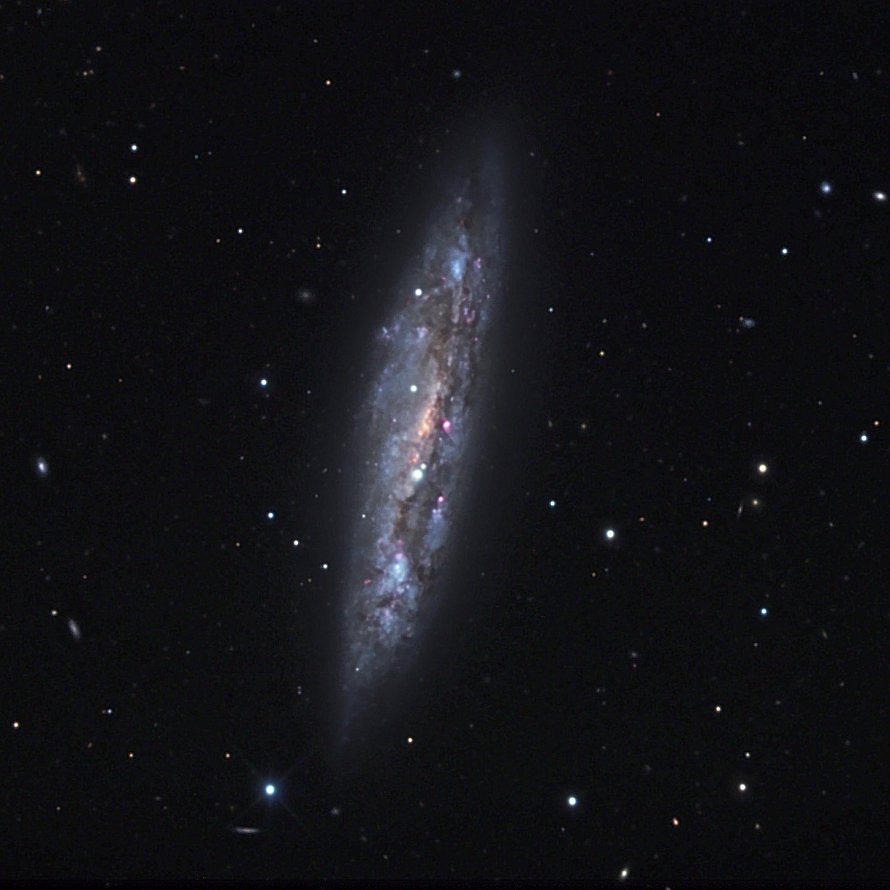M108 (NGC 3556) - Surfboard Galaxy
Messier 108 (NGC 3556), also known as the Surfboard Galaxy, is a barred spiral galaxy located in the constellation Ursa Major in the Ursa Major Group of galaxies. M108 is 46000000 light years away from Earth.
M108 is best viewed during early spring, is magnitude 10.7, and can be viewed with small telescope. M108 is 8.7' x 2.2' in apparent size. For reference, the full moon is 30'.
Observing difficulty: Hard
- Name:
- Surfboard Galaxy
- Type:
- barred spiral galaxy
- Constellation:
- Ursa Major
- NGC or IC:
- NGC 3556
- Magnitude:
- 10.7
- Viewing:
- small telescope
- Size:
- 8.7' x 2.2'
- Distance (light years):
- 46000000 LY
- RA:
- 11h 11.6m
- Dec:
- 55 41'
- Season:
- early spring
- Galaxy group:
- Ursa Major Group
- Messier Marathon #:
- 37
* The naked eye can see up to magnitude ~7-8 objects under ideal dark sky conditions.
An Elusive Barred Spiral Galaxy
Messier 108, also known as M108 or NGC 3556, is an isolated barred spiral galaxy situated in the constellation Ursa Major, "The Great Bear". This deep-sky object was discovered by Pierre Mechain in 1781, and later catalogued by Charles Messier, though it wasn't officially included in the Messier catalogue until 1953 by the astronomer Owen Gingerich.
Characteristics of Messier 108
Messier 108 boasts a morphological classification of SBc, indicating that it is a barred spiral galaxy with somewhat loosely wound arms. This galaxy's disk appears nearly edge-on from our perspective on Earth, giving it an elongated and obscured appearance that is significantly devoid of a central bulge.
The galaxy is notable for its high levels of star-forming activity, as evidenced by numerous nebulous areas glowing with the light of new stars. Radio observations have revealed the presence of substantial quantities of atomic hydrogen gas within M108, fueling its active star formation. Several supernovae have also been observed in Messier 108 over the past few decades, indicating a dynamic and active stellar population.
Magnitude and Distance
Messier 108 has an apparent magnitude of approximately 10.7, which means it's not visible to the naked eye but can be viewed through a small telescope under ideal viewing conditions. In terms of its distance from us, this galaxy resides roughly 46 million light-years away in the Ursa Major group of galaxies, which is part of the Ursa Major Supercluster.
Finding and Observing Messier 108
Locating M108 can be relatively straightforward due to its proximity to the bowl of the Big Dipper, an asterism in Ursa Major that is well-known to many stargazers. The galaxy is found just 1.5 degrees southeast of the bright star Beta Ursae Majoris, also known as Merak. Despite this, its dimness and edge-on appearance can make M108 somewhat challenging to observe.
Small telescopes might only reveal a faint, nebulous smudge, but larger amateur scopes can begin to show M108's elongated structure and hint at some mottling within the galaxy due to its dust lanes and star-forming regions. The observation of this object is certainly favored by dark skies and a larger aperture telescope.
Overall, Messier 108 provides an interesting observational challenge for amateur astronomers and holds significant scientific interest as a site of ongoing star formation and supernova activity.



